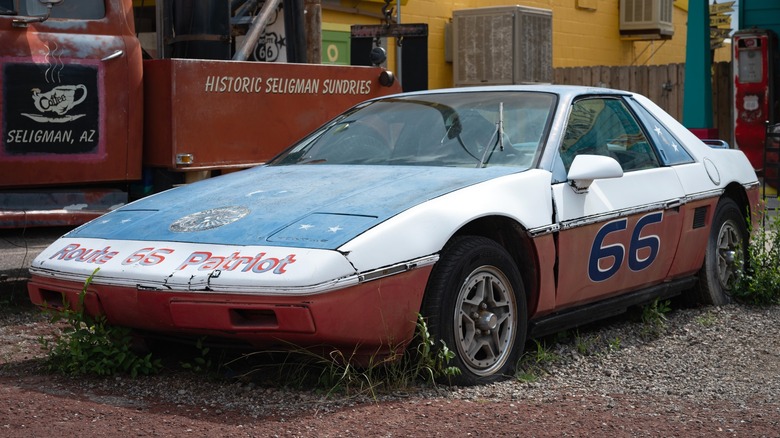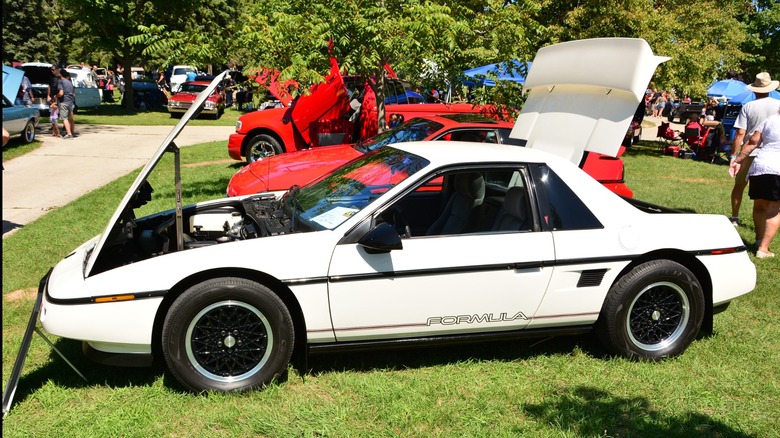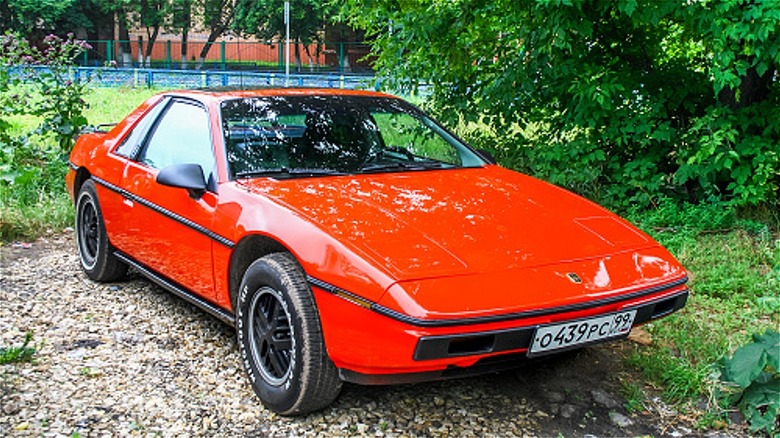
adolf martinez soler/Shutterstock
Forty years ago, a sprightly looking two-seater burst onto the U.S. market, grabbing the imagination of everyone who wanted a Ferrari but had to work a normal day job. The Pontiac Fiero was introduced in 1984 with an angular new look for American car buyers.
As we know, looks aren’t everything and the public soon learned that corners cut in the manufacturing of this affordable car took some of the excitement out of driving it. MotorTrend called the stock ’84 «painfully slow.» But the first model year still sold well, allowing Pontiac room to tweak and upgrade the car for subsequent models. By the end of its production run in 1988, the performance and styling upgrades of the cool-looking Fiero GT trim showed where this car could have gone — had it only not been recalled multiple times for engine compartment fires. We’ll explain more about the fires as we look at three facts about the Fiero that probably only hardcore fans know.
America’s first mid-engine, rear-wheel … commuter car
With a nose like a Ferrari 308, the Fiero was Pontiac’s bid to reignite waning excitement for its brand. The vice president of Pontiac, Bill Hoglund, was instrumental in making the Fiero a reality. He envisioned a two-seater, mid-engine sports coupe — America’s first production car of that type. However, parent company GM wanted a commuter car with great fuel mileage that did not mess with the success of its Corvette. Fiero was allotted a small budget for development of this unicorn.
The battle between racing-inspired fun and affordable reality began. The Fiero badge of a rearing horse — albeit, with wings — conveyed track-hugging aspirations to match its Italian lookalike. In reality, GM had a budget to meet and used off-the-shelf parts and sections of vehicles that worked well in its other cars. GM decided that would borrow the front-wheel-drive, non-performance-inspired Chevy Citation’s transaxle and MacPherson strut front suspension to use in the back end of the Fiero. To keep the back wheels going straight, the repurposed Citation steering tie rods had to be fixed in place on the rear-wheel drive coupe.
GM also sandwiched its all-purpose, 2.5-liter inline-four engine behind the passenger compartment to squeeze out an estimated 29-33 mpg on the hwy. Unfortunately, that sizable engine also only squeezed out 92 horsepower. The ’84 Fiero was no Ferrari.
Featured image by Greg Gjerdingen via Wikimedia Commons | Cropped and scaled | Public domain or CC BY 2.0
This pint-size wedge of plastic weighs more than a metal Miata

Tony Savino/Shutterstock
Like that other rear-wheel-drive, manual transmission coupe, the Fiero is tiny. But the first Fiero released in 1984 — the lightest — weighs about 350 pounds more than the first Miata. At 160.7 inches in length and 68.9 inches in width, the Fiero has a slightly bigger footprint than the Miata’s 156.5 inches x 65.9 inches so, of course the Pontiac is heavier, right?
But not everyone knows the Fiero was an early adopter of plastic body panels, designed in part to reduce the car’s weight and make it more fuel efficient. The panels were attached to a steel frame, effectively a roll cage. If the plastic helped make the Fiero lighter, why wouldn’t the Miata’s mostly aluminum and steel panels make it weigh more?
The answer lies, in part, under the hood and under the trunk lid: the first Miata was built with a small, 1.6 liter in-line four, whereas Pontiac used its beefy 2.5-liter inline-four, aka the Iron Duke for the Fiero.
Odds of an original 1984 Fiero catching fire: 1 in 400

Darthart/Getty Images
The little Pontiac was plagued throughout its life by recalls for fires in the engine and engine compartment. 1984 was the most flammable year for the Fiero, with wiring harness issues, engine overheating issues, and connecting rod damage to the engine causing hundreds of fires in its 4-cylinder commuter car line. This led to a recall of 125,000 model year 1984 Fieros in 1987, as the fire rate approached 1 out of every 400 cars. Eventually, sales dropped off for the Fiero, which was discontinued a year later.
Despite Pontiac making several corrections to the ’84 design in Fiero’s later model years, the NHTSA still issued recalls in 1989 and 1990 for potential engine compartment fires in both 4-cylinder and 6-cylinder engines. These recalls focused on a variety of leaks — transmission oil cooler, oil, and fuel, to name a few.
All this might make you think there is little demand for a flaming, underpowered commuter car from the ’80s that originally sold for as little as $7,679. As it turns out, there are still people out there who would pay good money for this unique American mid-engine.